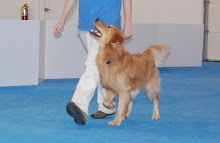- 2 teams walk towards each other, turning away while at a success point.
- 1 team walking towards a person approaching, both turning away at a success point.
- A team walking towards a stationary dog and handler, both turning away at a success point.
- A team walking towards a stationary person, both turning away.
This is really nice for teaching people to judge how much their dogs can handle. We play it very safe with the reactive dogs. With the shy dogs, slight avoidance signals us to turn away on the next repetition. For the excitable dogs, any jumping forward signals us to turn sooner on the next repetition. The dogs give the handlers feedback about the choice of the turn around point.
This "success point" changes over time and the many repetitions start to get the handlers to be very aware about how they are working their dogs. A dog jumping up is no longer "Making mistakes," "having a bad day, " "Being awful!" The dog is saying "you were too close." Even though I have verbally discussed this in class, it wasn't enough. Now, students are making much better choices. It's black and white for them. Turning dog = slightly closer next time. Jumping/moving away = more distance next repetition.
.
In a class last night, we were doing an exercise where two teams walked toward each other, then away. One handler was clicking as the dog was looking ahead but walking nicely. The dog is slightly reactive but also has a lot of dog friends and likes playing with those dogs. It is good he can remain next to the handler while walking forward. But by reinforcing looking at the other dogs, we were increasing their relevance in the environment. * We clicked for turning away (the goal of the exercise to begin with). Soon the dog was glancing at the other dogs but not doing the stare he previously was trying.
Another component is the type of turn. A U turn to block the dog gives the advantage of a visual and physcial block between the dog and whatever else, but also allows the dog more leash to move TO the thing (not good for excitable or reactive dogs). An about turn, with the dog on the outside, limits the leash but leaves the dog "stranded" between the handler and the "whatever else" for a moment. The dog could make a good choice....or a not so good choice. The other option, is a front-cross turn, both handler and dog rotating to each other, then walking away with the dog on the opposite side from where he started. This limits the leash, this refocuses the dog on the handler, the handler is watching the dog the whole time, and most people can turn fastest this way (once they understand it!).
We talked about all the options last night and then tried the variations. My favorite is still the front cross turn.
* Yes, I'm aware of look-at-that type exercises. We would probably introduce that with neutral things, then moving parallel to things, then right towards the distractions. The timing would be different than what was being used in this exercise (Duration of nice walking forward to the other dog).




No comments:
Post a Comment